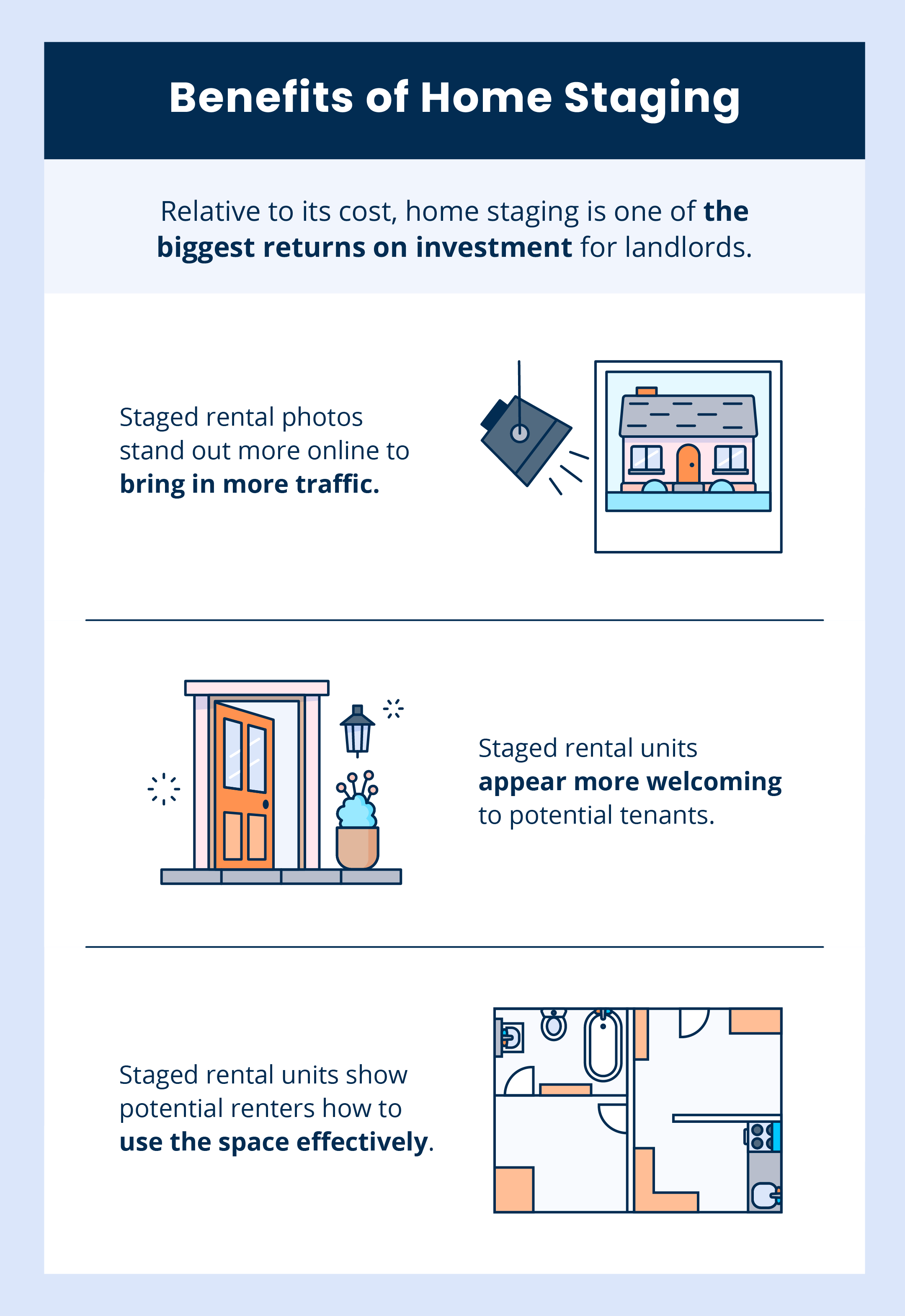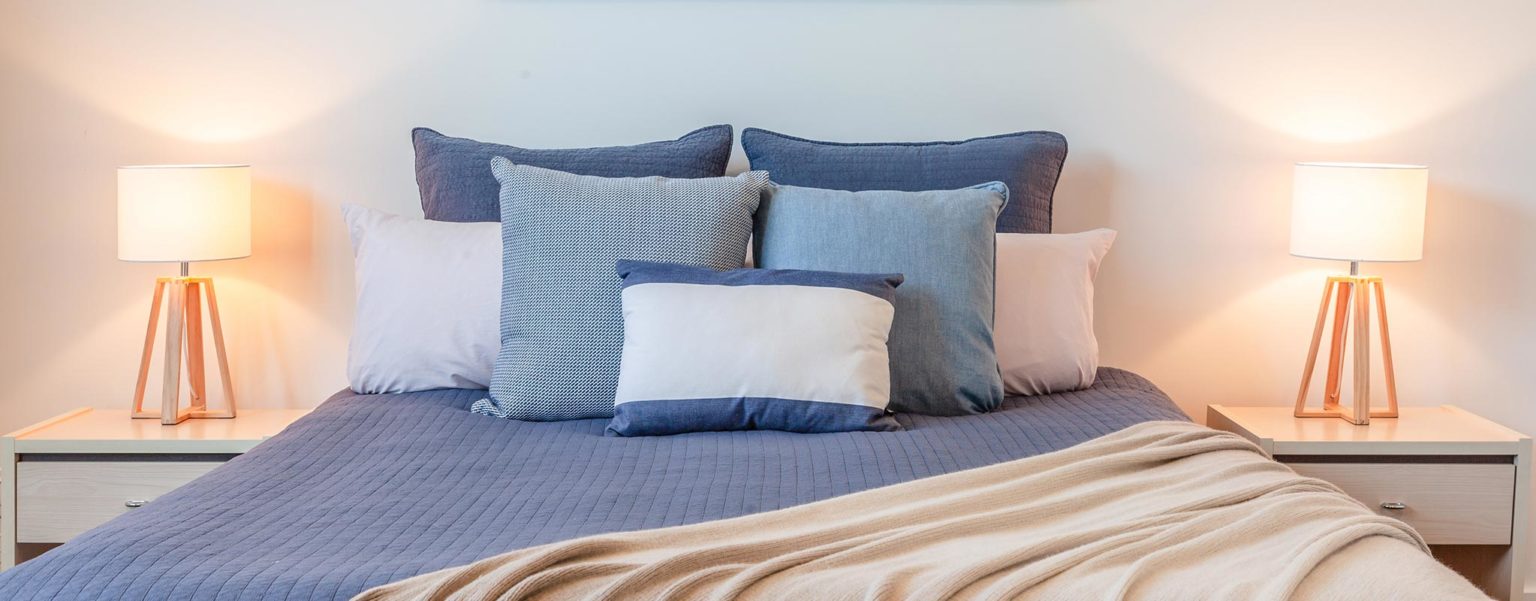Every day a rental property sits vacant means lost income for landlords. Fortunately, staging a house can help a new tenant sign a lease quickly so you can get back to earning income.
At TurboTenant, we’ve helped more than 550,000 independent landlords find tenants, so we’ve put together a list of the 15 best tips to make staging your rental property a worthwhile investment.
What is staging a house?
Staging a house is the practice of preparing a house to rent by making it appealing to prospective renters. A well-staged home highlights the home’s assets with a combination of decor, furniture placement, and wall color. Cleaning and repairs throughout the home (and outside) are also included in home staging. Visitors touring the home (or viewing it online) see a staged home as “move-in ready.”
As a landlord staging a rental home, it’s crucial to create an emotional connection between the viewer and the rental property so the potential renter can envision themselves living in the home. It also shows the renter that the property has been cared for, making them feel at peace when signing a lease.
When listing a rental unit, staging can be tricky if the unit is currently occupied. You’ll have little to no control over the unit’s appearance, so you’ll need to communicate clearly with the current tenant. Let them know when you will be coming to take photos or walk a potential tenant through the unit, and encourage them to tidy up.
If the rental unit is vacant, it’s much easier for you to stage because you’ll know it’s in perfect condition, but it will cost a bit upfront.

Does Staging a House Make a Difference?
The benefits of staging a home make it well worth the investment since it is relatively easy to do. In fact, it is considered one of the best returns on investment you can make when listing a home for sale or rent.
Impact of Staging on Online Listings
According to the National Association of Realtors, buyers are 41% more likely to walk through a home they see online, so having a digital presence for your rental is a must.
One of the most essential components of an online listing are photos that highlight the best features of your rental unit. Photos of empty rooms often appear bland and unwelcoming, no matter how clean and well-kept the unit may be. By staging a house, your photos will be more eye-catching, which can increase foot traffic, meaning your rental unit will sit empty for less time.
Impact of Staging on Price
Staging a home can increase the price. Staged homes sell for 20% more than unstaged ones. Additionally, 23% of buyer’s agents report that staging a home increases offer values by 1%-5%, and 18% report an offer increase of 6%-10%.
These stats suggest that you will be more successful in asking for a slightly higher rent for a home that has been effectively staged.
Impact of Staging on Time on Market
Staging a home can decrease the amount of time a home is listed. Staged homes tend to sell 88% faster than unstaged homes, which suggests a similar pattern would exist for rentals.
53% of realtors report a home is on the market less when it is staged.
If you want your rental unit to be generating income as quickly as possible, you’re better off taking the time and money to stage it.

How Much Does Staging a House Cost?
Staging a house can cost on average anywhere from $300 to $1500. The cost varies depending on how you decide to go about it and the extent of what needs to be done. You can opt to stage the home yourself, hire a professional, or use a virtual home staging service.
DIY
The best option for staging a house on a budget is to do it yourself. In most cases, you can complete staging projects in a weekend or two if the property is in good condition.
On average, DIY home stagers spend about $300 on various projects, including paint and landscaping.
Hiring a Professional
Professional stagers are more expensive than the DIY approach, but they have access to furniture, decor, and other elements that make a house feel like a home.
On average, hiring a pro will cost you $1,500. You can also opt to have a professional stager tour the rental unit and tell you what needs done, and then act on that information yourself.
Virtual Home Staging
Virtual home staging is the process of taking photos of empty rooms and using photo editing software to add in furniture and accessories to stage the home. It can be cheaper than DIY and hiring a professional, but it has its limitations since people who tour the rental will see its current state.
If you want to use virtual home staging services, it’s best to clean the rental from top to bottom and make necessary repairs. Then use the virtual staging to add furniture. If you use it to change the paint color or make the windows bigger, potential tenants might be disappointed when they enter the property. It’s also a good idea to put a watermark on the photo indicating it has been virtually staged.

Best Home Staging Tips
Home staging seeks to make the home appealing to as many people as possible. This is about appearance, not practicality, so how you stage a home is probably different from how you would design it if someone were living there.
We’ve collected some of the best home staging tips to help you get your rental unit off the market in the least amount of time for top dollar.
1. Focus on the Most Effective Areas
There’s truth in the saying, “Kitchens and bathrooms sell houses,” so focus most of your energy there. The living room, dining room, and primary suite should also be areas of focus. Since more people are working remotely, office spaces have also increased in importance for renters, so stage a dedicated office space if you can.
2. Clean and Deodorize
Clean the rental unit like you’ve never cleaned it before. Even get those areas you think no one would ever see, like behind the toilet and the baseboards behind furniture. Clean appliances thoroughly and remove references to pets like toys and beds.
Opt for natural odor removal remedies rather than artificial scents, as many can be too harsh and trigger allergic reactions.
3. Depersonalize
Keep the decor appealing to the most people possible. Remove photos, keepsakes, and toys from sight, and clear off counters in the kitchens and bathrooms. By removing signs of the current renters, future tenants will have an easier time picturing the house as their own.
When in doubt, think about making the unit look like a model home rather than a lived-in home.
4. Declutter
Pack up all the nonessentials that you don’t use on a day-to-day basis and put them in storage. Sell or donate whatever you don’t wish to keep. Organize what remains in an aesthetically pleasing way.
Don’t be tempted to stuff closets, cabinets, and basements with everything you took out of the main living areas. One of the biggest tenant complaints is a lack of storage, so by clearing out storage areas, you’re showing that the unit has plenty of space.
5. Deep Clean or Update Flooring
Have the carpet cleaned, and if the stains can’t be removed, replace it. Many renters are looking for the ease of hardwood or laminate flooring, so consider replacing any carpet in the main living areas. Bathrooms are also great places to update flooring because of their small footprint.
6. Carefully Consider Furniture
Odors (especially from pets) tend to linger in furniture, so deodorize any existing furniture. You can also update older pieces with neutral slipcovers and new throw pillows.
Rearrange furniture (or remove some pieces entirely) to create conversation groupings, but keep walkways clear to give the illusion of more space. Ensure potential renters have easy access to fireplaces, windows, and built-in bookcases.
7. Repaint
One of the easiest facelifts for any property is adding a new coat of paint. Not only does it cover up any knicks or holes left by previous tenants, but it also masks odors that have seeped into the walls.
Opt for neutral colors so the unit appears move-in ready. If the unit lacks natural light, use a semi-gloss or gloss paint so the light reflects throughout the room.
8. Make Necessary Repairs
Potential renters don’t want to see any obvious problems with the property, so repair any visual issues. Fix that leaky faucet, replace the peeling caulk in the bathroom, and patch any holes or cracks.
9. Liven Up the Curb Appeal
The outside of a home can influence a potential renter’s decision before even stepping inside the home. Help your property put its best foot forward by freshening up the landscaping, power washing the house and the walkway, tidying up the yard, and planting a few brightly colored flowers. Change out the house numbers and the mailbox, and paint the front door.
10. Brighten Things Up
No one wants to live in a cave, so take some time to inspect your lighting. Dust off every fixture, and consider replacing any that appear dated. Ensure all the lightbulbs are working, and replace any that flicker or are burnt out. When potential renters visit, leave all the lights on and the blinds open.
11. Add Greenery
With all the health benefits of indoor plants, it’s a good idea to add a real plant wherever you can when staging a rental home. Not only will it look nice and soothe the people walking through the unit, but it can also help improve the air quality of the rental.
12. Freshen Up
Open the windows to let some fresh air in about a half-hour before a showing. Light a candle with a subtle yet comforting scent, like vanilla, or stick some cookies in the oven. You can even boil a mixture of cinnamon sticks, apples, and oranges in the fall. Finally, put some fresh flowers on the table as a centerpiece.
13. Accessorize Wisely
When staging a home, you want it to be a blank canvas but still have charm. Use the rule of threes when accessorizing: arrange accessories in a triangle, and vary the height and width of the items. Hang curtains at the ceiling and let them hang to the floor.
14. Aim for Appearance, Not Practicality
Don’t worry if the television isn’t visible from every piece of furniture in the living room, or if you can’t open a cabinet completely. Nothing about the layout of your furniture needs to be practical. Instead, aim to make the most appealing arrangement you can.
15. Use the Psychology of Color to Your Advantage
While neutrals are best for wall colors, use the psychology of color to your advantage when accessorizing. Warm colors create a cozy vibe, while cool colors enlarge a space. Use pops of color to draw a renter’s eyes to focal points of the rental unit you want to feature, like built-in bookshelves or a fireplace.
If the property is empty, set aside a few days to devote to staging the unit. Make sure to complete any necessary repairs before showing the home. If the property is still occupied, talk to the current tenant about cleaning, decluttering, and depersonalizing. Remember to use money from their security deposit if repairs beyond wear and tear need to be made.
Once you’re finished staging, take high-quality photos and determine if any of your repairs or upgrades impact your rental rate. Craft the perfect online listing and wait for tenants to come to you!








